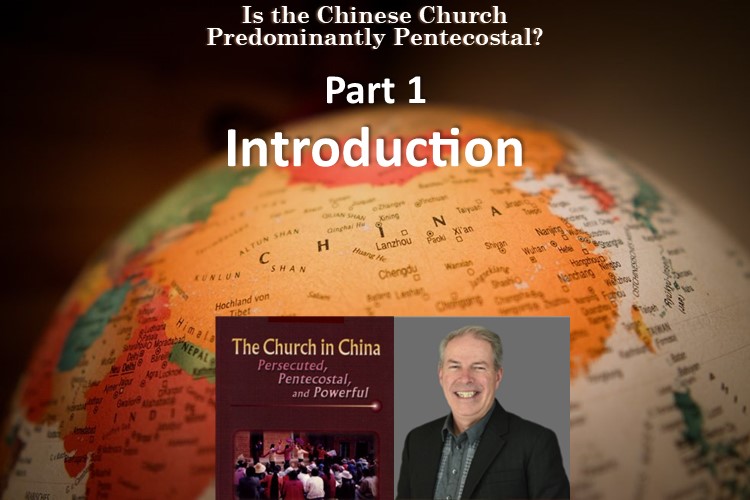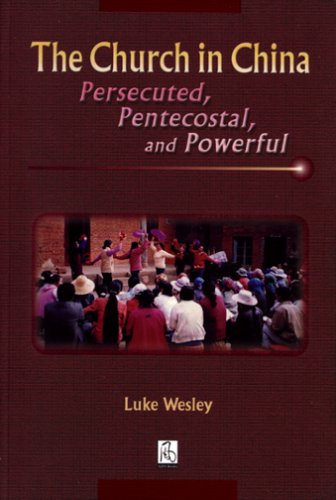Robert Menzies: Is the Chinese Church Predominantly Pentecostal? Part 1: Introduction

Is the Church in China Predominantly Pentecostal?
Part 1: Introduction
By Robert P. Menzies
The Wind of the Holy Spirit Will Blow Everywhere
From the East coast to the West coast/
The wind of the Holy Spirit will blow everywhere/
From the East to the West/
The glory of the Holy Spirit will be released/
Good news comes from heaven/
Good news rings in the ear/
Causing dry bones to become moist/
Frail bones to become strong/
Full of the Holy Spirit, we will not turn back/
Step by step we go to distant places/
The lame skipping/
The mute singing/
The fire of the Holy Spirit, the longer it burns the brighter it gets.[1]
The Urging of the Holy Spirit
The Holy Spirit is urging/
Distant lands call/
Asking for the sound of salvation to ring in their ears/
Countless pairs of expectant eyes/
Oh, have not seen, have not heard the servants of God/
No matter what you feel/
No matter what you see/
We must declare the good news everywhere/
The Lord has already enabled us to see the land/
Oh, servants of God, you must boost your courage/
The Lord has already won the victory/
Satan has been bound/
Only one step further/
And we enter Canaan land.[2]

The series, “Is the Chinese Church Predominantly Pentecostal?” is an excerpt from The Church in China. Robert Menzies used a pen name, Luke Wesley, to write The Church in China: Persecuted, Pentecostal, and Powerful (Baguio, The Philippines: AJPS Books, 2004).
Read the 2023 Author’s Preface to this series.
It is now apparent that since the early 1980s the Church in China has experienced unprecedented growth. Once viewed as an essentially foreign faith, Christianity has taken root in the Chinese soil. And it has blossomed. If the trends of the past two decades remain constant, by 2020 there will be more evangelical Christians in China than in any other country in the world.[3]
Researchers are agreed that the form of Christianity that has emerged in China is both evangelical in character and Chinese in expression.[4] It is evangelical in that the vast majority of Chinese believers exhibit a firm belief in the authority of the Bible, faith in Christ as the sole means of obtaining salvation, and the necessity of evangelism.[5] And yet this evangelical faith has been expressed in ways that are especially appropriate to the Chinese context. Church life is often experienced in small groups that feature close relationships and family ties. There is a strong emphasis on the miraculous, with prayer for healing taking on an important role in the life of faith. The experiential dimension of Christian spirituality, expressed in prayers and worship charged with deep emotion, is significant to many Chinese believers. And the vast majority of Christians in China worship in ‘house churches’ (or, as some prefer, ‘autonomous Christian communities’) that are independent of state or foreign control.[6]
Observers in the West are still attempting to understand this burgeoning Christian movement and much is still unknown. It is evident that there is much to be learned from the Chinese Church, dynamic, multifaceted and polymorphous as it is, and that we in the West would do well to attempt to understand it more clearly. This is the case, not only because increasingly many western missionaries seek to minister in this great country; but, it is also the case because an understanding of the Church in China might shed light on ourselves, our own strengths and weaknesses, and stimulate new insights into our understanding and application of God’s Word. In short, a greater understanding of the Church in China might help us more fully understand and fulfill God’s plans and purposes for our lives.
Church life is often experienced in small groups that feature close relationships and family ties. There is a strong emphasis on the miraculous, with prayer for healing taking on an important role in the life of faith.
Methodology
In order to answer our question, I shall analyze the five largest house church networks in China. Based on my own personal interviews with leaders from these groups, additional information gleaned from other researchers, and an analysis of relevant written documents, I will seek to characterize these five groups in terms of the following four categories:
- Non-Charismatic – those Christians who believe that the Spirit’s work flows out of regeneration and who deny both a Baptism in the Spirit distinct from conversion and the validity of at least some of the gifts of the Spirit listed in 1 Cor. 12:8-10 for the church today.
- Charismatic – those Christians who believe that all of the gifts listed in 1 Cor. 12:8-10, including prophecy, tongues, and healing, are available to the Church today.
- Pentecostal – those Christians who believe that all of the gifts listed in 1 Cor. 12:8-10 are available to the Church today and who also believe that the Bible encourages every believer to experience a Baptism in the Spirit, an empowering for service distinct from regeneration.[9]
- Classical Pentecostal – those Christians who, in addition to the beliefs ascribed to Pentecostals above, also affirm that speaking in tongues is the accompanying sign of Baptism in the Spirit.
I am using the terms listed above as theological rather than ecclesiastical descriptions. The New International Dictionary of Pentecostal and Charismatic Movements (NIDPCM) tends to define the terms based largely on ecclesiastical considerations. Therefore the NIDPCM classifies 99% of the 54.2 million Pentecostals and charismatics who it claims reside in China as “neocharismatics.” The term “neocharismatic” refers to charismatics not affiliated with the historic, classical Pentecostal groupings or to traditional, mainline denominations.[10] Of course, by definition, virtually all of the charismatic house church Christians in China would fall into this category. This system of classification is less helpful for elucidating the specific nature and theological orientation of the various groups in the Chinese church. We are primarily interested in what they believe.
The experiential dimension of Christian spirituality, expressed in prayers and worship charged with deep emotion, is significant to many Chinese believers.
It should also be noted that all of the categories listed above are compatible with the term ‘evangelical’. With the designation evangelical, I refer to those Christians who affirm: the authority of the Bible; that salvation is found only in Christ; and that evangelism is an important part of the Christian’s mission in the world. As I have already noted, the vast majority of Chinese Christians are evangelical in this sense. And, I might add, all five of the house church networks which we will analyze are also evangelical in nature.
In addition to defining key terms, I would also like to clarify the nature of my sources. I will be working with a variety of oral and written sources. First, I will utilize notes from my personal conversations and interviews with various house church leaders. Second, I will also draw upon responses to questions which I have posed to others who are experienced researchers of Christianity in China. Most of these researchers wish to remain anonymous so that their continued service in China might not be jeopardized. For this reason I will describe and list these sources as follows:
“A” – refers to notes sent to me on August 28, 2003 by a researcher who is associated with a large, evangelical, and generally non-charismatic denomination.
“B” – refers to notes sent to me on Sept. 1, 2003 by an independent researcher who is affiliated with a non-denominational mission.
“C” – refers to notes sent to me on Sept. 9, 2003 by a missionary in the classical Pentecostal tradition who works closely with house church groups in China.
“D” – refers to written notes and oral comments presented to me within the past year from an independent Pentecostal missionary who works closely with several of the house church networks listed above.
A third source of information will come from documents draw up by the house church networks themselves, especially the Statement of Faith produced and signed by leaders of several of the churches listed above on November 26, 1998.[12] Finally, I shall also draw from a number of books and articles which speak to our topic.

Image: Christian Lue
The five house church networks which I will examine are: China for Christ, a group with origins in the Fang Cheng district of Henan Province; The China Gospel Fellowship, a group which began in the Tang He District of Henan; The Li Xin Church, which stems from Li Xin region in Anhui Province; the Yin Shang Church, which also has its origins in Anhui Province; and finally, the Word of Life Church, sometimes called the “Born Again Movement”, which was founded by Peter Xu. These groups have been chosen for analysis because it is generally agreed that they represent the five largest house church networks in China.
It is extremely difficult to determine with any degree of precision the size of these groups. Estimates for these groups run as high as 12 million for China for Christ (Fang Cheng), 10 million for the China Gospel Fellowship, five million for the Word of Life, and five million each for the two Anhui groups.[13] My purpose here is not to argue for specific numbers, but rather to affirm that all of the researchers contacted agreed that these five house church networks represent a significant majority of house church Christians in China. This is especially significant in that virtually all researchers also agree that house church Christians represent the vast majority of Christians in China today. Thus, it is reasonable to conclude that these five groups represent a very significant cross-section or sampling of the Chinese Church.
PR
Next Issue: “The House Church Networks: A Theological Assessment”
This excerpt is part of Chapter 3 from The Church in China: Persecuted, Pentecostal, and Powerful (Baguio, The Philippines: AJPS Books, 2004). Used with permission.
Notes
[1] Lu Xiaomin, Sounds of the Heart, p. 806 (Song #747).
[2] Lu Xiaomin, Sounds of the Heart, p. 826 (Song #767).
[3] Tony Lambert, China’s Christian Millions (London: OMF/Monarch Books, 1999), p. 179. In this book Lambert offered what is by all accounts a conservative estimate of the number of evangelical Christians in China: 30-50 million.
[4] Due to the limitations of my knowledge, I am not able to include Chinese Roman Catholics in this study. When I use the terms Christianity or the Church, it should be understood that I refer to Protestant Christianity and the Protestant wing of the Christian Church.
[5] On the evangelical character of the Chinese Church, see Tony Lambert, The Resurrection of the Chinese Church (Wheaton, IL: OMF/Harold Shaw Publishers, 1994), pp. 282-283 and China’s Christian Millions, pp. 30-33, 45, 48, 188; Alan Hunter and Kim-Kwong Chan, Protestantism in Contemporary China (Cambridge: Cambridge University Press, 1993), p. 82; Ryan Dunch, “Protestant Christianity in China Today: Fragile, Fragmented, Flourishing” in Stephen Uhalley, Jr. and Xiaoxin Wu, eds., China and Christianity: Burdened Past, Hopeful Future (London: East Gate/M.E. Sharpe, 2001), p. 215.
[6] The emphasis on healing and the miraculous in the Chinese Church is noted in Hunter and Chan, Protestantism, pp. 85, 145-146; Lambert, Resurrection, pp. 112-114 and China’s Christian Millions, p. 112; and Dunch, “Protestant Christianity,” p. 203 and the experiential focus of the Chinese Church is highlighted in Dunch, “Protestant Christianity,” pp. 203, 215-16; and Hunter and Chan, Protestantism, pp. 85. 140, 155. Some researchers prefer to use the term ‘autonomous Christian communities’ rather than ‘house church’, see in this regard Hunter and Chan, Protestantism, p, 81.
[7] Stanley Burgess and Eduard M. Van der Mass, eds. The New International Dictionary of Pentecostal and Charismatic Movements (revised and expanded; Grand Rapids, MI: Zondervan, 2002), p. 58.
[8] Lambert, China’s Christian Millions, p. 45. Unfortunately, Lambert does not offer a clear definition of the terms, “charismatic” or “Pentecostal.”
[9] This empowering experience might be designated by various terms, including ‘being filled with the Spirit’ or ‘anointed by the Spirit’. However, crucial concepts would include the belief that this experience is given by God in order to equip the believer for service, that it is available to every believer, and that it is logically distinct from conversion.
[10] See the NIDPCM, p. xviii-xxi, 58.
[11] Hunter and Chan, speaking of China, correctly note that “within the Pentecostalist movement one can find relatively restrained as well as exuberant groups…” (Protestantism, p. 155).
[12] See the English translation provided by Lambert in China’s Christian Millions, pp. 60-64.
[13] These numbers are taken from D, but are also very much in line with the estimates given to me by B, with one exception. D did not give an estimate for the number of believers in the Word of Life Church. B noted that the Word of Life group claims that it represents 23 million believers. This group is quite fragmented and it is difficult to take this estimate seriously. In 1998 an article in Christianity Today suggested that this group totaled around three million believers (see Timothy C. Morgan, “A Tale of China’s Two Churches,” Christianity Today 42 (July 13, 1998), pp. 30-39). Although it is likely that this group has grown significantly since then, five million appears to be a more realistic number. A and C did not offer specific estimates, but A indicated that these five groups represented a significant majority (60%) of the house church Christians in China.
Category: Church History, Summer 2022


